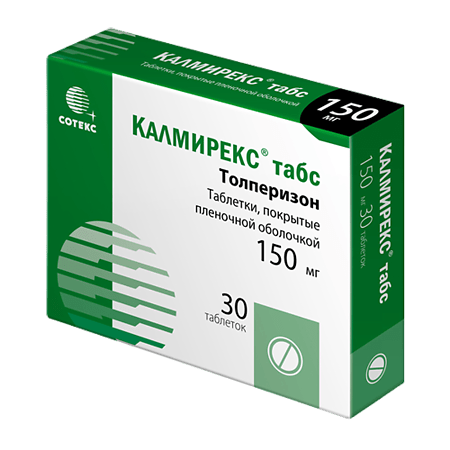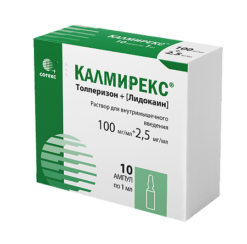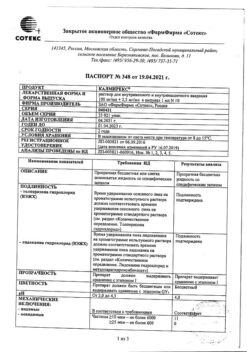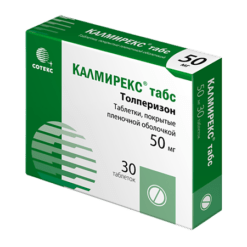No products in the cart.
Calmirex, 150 mg 30 pcs.
€11.60 €9.67
Description
Pharmacotherapeutic group: myorelaxant of central action.
ATX code: M03BX04
Pharmacological properties
Pharmacodynamics
Tolperizone is a myorelaxant of central action. The mechanism of action is not fully elucidated. Tolperisone has a high affinity for nervous tissue, reaching the highest concentrations in the brainstem, spinal cord and peripheral nervous system. The main effect of tolperizone is mediated by inhibition of spinal reflex arcs.
This effect, together with the elimination of the facilitation of excitation conduction along the descending pathways, probably provides the therapeutic effect of tolperizone. The chemical structure of tolperizone is similar to that of lidocaine. Like lidocaine, it has a membrane-stabilizing effect and reduces electrical excitability of motor neurons and primary afferent fibers.
Tolperizone dose-dependently inhibits the activity of potential-dependent sodium channels. Accordingly, the amplitude and frequency of the action potential decreases. A suppressive effect on potential-dependent calcium channels has been proven. It is assumed that in addition to its membrane-stabilizing effect, tolperizone may also inhibit mediator release. Tolperizone has some weak α-adrenergic antagonist properties and antimuscarinic action.
Pharmacokinetics
Tolperisone is well absorbed in the small intestine after oral administration. Maximum plasma concentration is noted 0.5-1 h after ingestion. Because of the pronounced presystemic metabolism the bioavailability is about 20%.
Fat-rich foods increase the bioavailability of ingested tolperizone to approximately 100% and increase the maximum plasma concentration by approximately 45% compared to the drug taken on an empty stomach, delaying the time to maximum concentration by approximately 30 minutes. Tolperisone is extensively metabolized in the liver and kidneys. The compound is almost completely (more than 99%) excreted by the kidneys in the form of metabolites. Pharmacological activity of the metabolites is unknown. The elimination half-life after oral administration is about 2.5 hours.
Indications
Indications
Active ingredient
Active ingredient
Composition
Composition
Active ingredient:
How to take, the dosage
How to take, the dosage
Orally, after a meal, without chewing, without breaking the tablet, with a small amount of water. The bioavailability of tolperisone is reduced when taken on an empty stomach. Take 50 mg 3 times a day, gradually increasing the dose to 150 mg 3 times a day.
Patients with renal impairment
The experience of using tolperizone in patients with renal impairment is limited; adverse reactions were more frequent in this category of patients. Therefore, in patients with moderate renal impairment the dose of tolperizone should be adjusted, with close monitoring of the patient’s health status and renal function monitoring. In patients with severe renal impairment, administration of tolperizone is not recommended.
Patients with hepatic impairment
The experience of using tolperizone in patients with hepatic impairment is limited, adverse reactions were more frequent in this category of patients. Therefore, in patients with moderate hepatic impairment the dose of tolperizone should be adjusted, with close monitoring of the patient’s health status and control of liver function. In severe hepatic impairment, administration of tolperizone is not recommended.
Interaction
Interaction
Studies of pharmacokinetic drug-drug interactions with the CYP2D6 isoenzyme marker substrate dextromethorphan have shown that concomitant use of tolperizone may increase blood levels of drugs that are metabolized primarily by the CYP2D6 isoenzyme (thioridazone, tolterodine. venlafaxine, atomoxetine, desipramine. dextromethorphan. metoprolol, nebivolol, perphenazine).
In laboratory experiments on human liver microsomes and human hepatocytes no significant inhibition or induction of other CYP isoenzymes (CYP2B6, CYP2C8, CYP2C9, CYP2C19, CYP1A2, CYP3A4) was found.
Due to the variety of metabolic pathways of tolperisone, increased exposure of tolperisone is not expected with concomitant use of CYP2D6 isoenzyme substrates and/or other drugs.
The bioavailability of tolperizone is reduced when taken on an empty stomach.
While tolperizone is a centrally acting drug, its sedative effect is very low. When concomitant use with other central muscle relaxants, the dose of tolperizone should be reduced.
Tolperisone increases the effect of niflumic acid, so a reduction in the dose of niflumic acid or other nonsteroidal anti-inflammatory drugs (NSAIDs) should be considered when used concomitantly.
Special Instructions
Special Instructions
The most common adverse reactions are hypersensitivity reactions. Allergic reactions range from mild skin to severe systemic, including anaphylactic shock. Symptoms of allergic reactions include redness, rash, urticaria, pruritus, angioedema (Quincke’s edema), tachycardia, arterial hypotension and shortness of breath.
Patients who are female and have a history of hypersensitivity to other drugs or allergic reactions are at higher risk.
In patients with known hypersensitivity to lidocaine, extra caution should be exercised when using tolperizone because of possible cross-reactions.
Patients should be alert for any symptoms of hypersensitivity. If symptoms occur, tolperizone should be discontinued immediately and a physician should be consulted immediately. Tolperizone should not be re-prescribed after an episode of hypersensitivity to a drug containing it.
The effect of the drug on the ability to drive and operate vehicles
CALMIREX® Tablets has no effect on the ability to drive vehicles and operate machinery.
Patients who have experienced dizziness, drowsiness, impaired attention, seizures, visual impairment or muscle weakness while taking the drug should see their physician!
Synopsis
Synopsis
Contraindications
Contraindications
Hypersensitivity to any of the ingredients.
Myasthenia gravis.
Childhood under 18 years.
Breast-feeding.
Lactose intolerance, lactase deficiency, glucose-galactose malabsorption.
Side effects
Side effects
The safety profile of the drug tolperisone is confirmed by data from use in more than 12,000 patients. According to these data, skin and subcutaneous tissue disorders, general, neurological and gastrointestinal disorders have been described most frequently.
In the post-registration period, the number of reports received about the development of hypersensitivity reactions associated with the use of tolperisone was about 50 to 60% of all reports received. In most cases, these were non-serious adverse reactions. Life-threatening allergic reactions were very rarely reported.
The incidence of side effects is classified according to World Health Organization guidelines, characterized as: very common (â¥1/10), common (â¥1/100, < 1/10), infrequent (â¥1/1000, < 1/100), rare (â¥1/10000, < 1/1000), very rare (< 1/10000), including isolated cases, frequency not known (cannot be calculated from available data).
Blood and lymphatic system disorders: very rare – anemia, lymphoadenopathy.
The immune system: rare – hypersensitivity reactions *, anaphylactic reactions, very rare – anaphylactic shock.
Metabolism and nutrition: infrequent – anorexia; very rare – polydipsia.
Psychiatric disorders: infrequent – sleep disturbance, insomnia; rare – weakness, depression; very rare – confusion.
Nervous system disorders: infrequent – headache, dizziness, somnolence; rare – attention deficit disorder, tremor, epilepsy, paresthesia, seizures, malaise, lethargy.
VIight: rarely – decreased visual acuity.
Hearing organ: rarely – tinnitus, vertigo.
Cardiovascular system: infrequent arterial hypotension; rare – angina pectoris, tachycardia, palpitations, blood rushes to the face; very rare – bradycardia.
Respiratory system: rarely – shortness of breath, nasal bleeding, tachypnea.
Gastrointestinal tract: infrequent – abdominal discomfort, dyspepsia, diarrhea, dry mouth, nausea; rarely – epigastric pain, constipation, flatulence, vomiting.
Hepatic and biliary tract disorders: rarely – moderate hepatic insufficiency.
Skin and subcutaneous tissue disorders: rare – allergic dermatitis, hyperhidrosis, itching, skin rash, urticaria.
Skeletal-muscular system and connective tissue disorders: infrequent – muscle pain, muscle weakness, pain in the extremities; rare – discomfort in the extremities; very rare – osteopenia.
Renal and urinary tract: rarely – enuresis, proteinuria.
General disorders: infrequent – asthenia, fatigue, malaise; rare – a feeling of intoxication, a feeling of warmth, irritability, thirst; very rare – discomfort in the chest.
Laboratory indices: rarely – hyperbilirubinemia, liver function abnormalities, thrombocytopenia, leukocytosis; very rarely – hypercreatininemia.
* Angioneurotic edema, including facial and lip edema (frequency unknown), has been reported in post-registration monitoring.
Overdose
Overdose
Pregnancy use
Pregnancy use
Pregnancy
The experimental studies on animals did not reveal teratogenic effect of tolperizone. Because of the lack of significant clinical data, tolperizone should not be used in pregnancy (especially in the first trimester), except when the expected benefit definitely justifies the potential risk to the fetus.
Breast-feeding period
As there are no data on excretion of tolperizone with breast milk, its use during breast-feeding is contraindicated.
Similarities
Similarities
Additional information
| Shelf life | 3 years. Do not use after the expiration date stated on the package. |
|---|---|
| Conditions of storage | In the dark place at a temperature not exceeding 25 0C. Keep out of reach of children. |
| Manufacturer | Ozon, Russia |
| Medication form | pills |
| Brand | Ozon |
Other forms…
Related products
Buy Calmirex, 150 mg 30 pcs. with delivery to USA, UK, Europe and over 120 other countries.


















